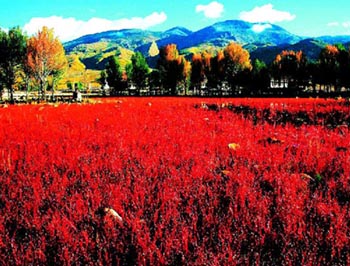| Tools: Save | Print | E-mail | Most Read |
| Endangered Beauty |
| Adjust font size: |
"Here be bears and wolves," the man warned, pointing out across the Tagong grasslands to the distant mountains. The peaks of Nyenpo Yurtse turned from crimson to pink as the sun sank below the horizon, the rugged terrain, long shorn of its timber reserves, falling suddenly into darkness. In the foreground below, a farmer, as if heeding the man's advice, was leading a flock of goats towards a low assemblage of wooden buildings while two large sows trotted hurriedly behind. Whether or not the rickety lodgings would protect them from bears and wolves was doubtful, but their very presence in this denuded valley seemed equally unlikely.
Sichuan Province holds a rich diversity of animals and plants, spread across a magnificent system of mountains, rivers, and lowland basins. Located at a continental biogeographic crossroads, the area ranges from dense virgin forests (7.46 million hectares in total) and pristine alpine lakes in the north and west, down to subtropical valleys in the south. One local official in Ganzi Tibetan Autonomous Prefecture says they feel like they are standing on a gold mine but do not know how to dig. What worries conservationists in China and abroad most is that they have already started mining regardless. Southwest of Chengdu the rich biodiversity of Hailuogou National Park draws a steady stream of affluent tourists-men in suits, with polished shoes, and women in equally formal attire and immaculate hair. Few people walk it, most preferring to be carried in chairs slung on two poles and hefted by two strong men. "We came to see the beauty of our country," one couple said when asked what had brought them to Hailuogou. "And we want to walk on the glacier." But according to Wang Wei, a tourism industry representative from Beijing, the Ice Waterfall at the Hailuogou Glacier is shrinking, the result of a combination of global warming and the impact of tourists and the newly built cable car. Adding to the overall degradation of the park, cement trails crisscross the area and tacky buildings spread like an alien fungi around the hot spring resorts. Further south, Yading National Park used to attract only the adventurous. This vast hinterland, dotted with the black and white tents and roaming yaks of the nomads, was originally only accessible by horseback, and later by four-wheel drive, but is now reached by a well-laid road that stretches into the wilderness. In the north, Wolong Nature Reserve is the largest of 16 reserves set aside for panda conservation. The pandas live in isolated groups, fewer than 20 in each, almost entirely in the mountain ranges in north and northwest Sichuan. Habitat encroachment and destruction is the greatest threat to the continued existence of the giant panda, as demand for land and natural resources increases each year. Eco-tourism seemed a good idea, but authorities face a dilemma-they need tourism to finance the conservation of the panda population, but the tourists are threatening the very animals they hope to save. Designated areas of the park are closed during the breeding period, but pandas are still susceptible to attack by their natural enemies, such as snow leopards or wolves, and although the government has imposed severe penalties on poachers, pandas are still accidentally injured or killed in traps set for bears and deer. Tourism is just one further potential menace. Zhuge Ren, chief representative of Green Globe 21 in China, says there are many examples of poor eco-tourism in the region and cites Hailuogou as an example. However, one example of good eco-tourism from which others might benefit is the National Wanglang Nature Reserve. Chen Youping, director of the reserve's management department, aims to provide professional equipment for observation and a complete database for conservation to visiting eco-tourists. "We have never paid special attention to real tourists and tourism development. We focus on scientists and scientific research," he says. With the government's continued support of conservation centers in Sichuan, such as the Chengdu Research Base of Giant Panda Breeding and growing awareness of environmental issues, it may be possible that in the future panda numbers will rise above the estimated 1,000 that are thought to exist in the wild today and that other animal and plant species will flourish in protected areas. Here might be bears and wolves, but for how long only the future will tell. The fate of the giant panda and other endangered species in the wild remains precarious. The scenic terrain, fiery flavors, and Buddhist villages of Sichuan will continue to draw the travelers. The steep mountain gorges and ravines surrounded by rocky peaks offer some protection. For now, the pale-green brooks and emerald mountain lakes set amidst the thick forests of rhododendron bushes and isolated enclaves of bamboo thickets still provide a sanctuary for the elusive inhabitants of this land, creatures that are found in no other place on earth. (China Daily November 13, 2006)
|
| Tools: Save | Print | E-mail | Most Read |
 |
| Related Stories |
|
|
Product Directory China Search |
Country Search Hot Buys |
